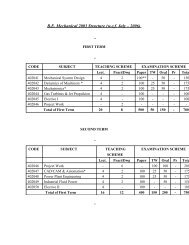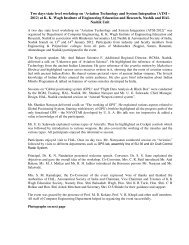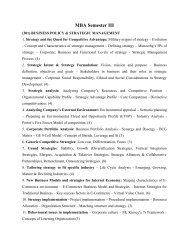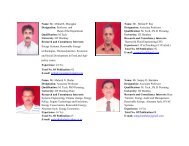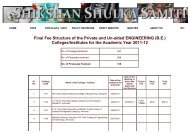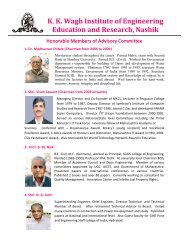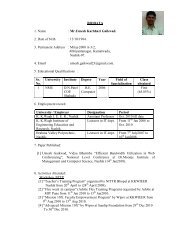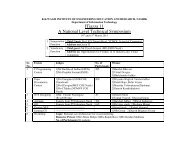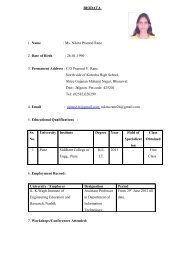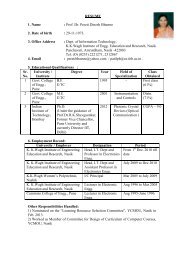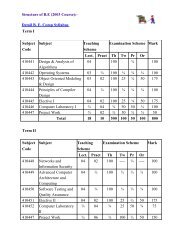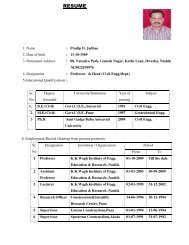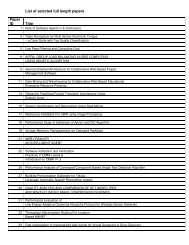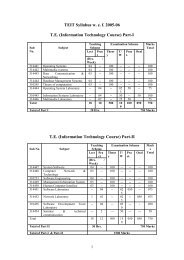University of Pune - K. K. Wagh Education Society
University of Pune - K. K. Wagh Education Society
University of Pune - K. K. Wagh Education Society
You also want an ePaper? Increase the reach of your titles
YUMPU automatically turns print PDFs into web optimized ePapers that Google loves.
Subject<br />
Code<br />
<strong>University</strong> <strong>of</strong> <strong>Pune</strong><br />
Structure <strong>of</strong><br />
BE (PRODUCTION ENGINEERING) 2003 Course<br />
Semester- I<br />
Subject<br />
Teaching<br />
Scheme<br />
(Hrs)<br />
Lecture<br />
Pr<br />
/D<br />
w<br />
Examination Scheme<br />
Th Tw Or Pr Total<br />
411081 Production 4 2 100 50 - - 150<br />
Management<br />
411082 Machine Tool 4 2 100 50 50 - 200<br />
Design<br />
411083 Manufacturing 4 2 100 - 50 - 150<br />
Automation<br />
and Control<br />
411084 Operations 4 2 100 50 - - 150<br />
Research<br />
411085 Elective I 4 - 100 - - - 100<br />
411086 Project<br />
Work**<br />
- 2 - - - - -<br />
Total 20 10 500 150 100 750<br />
** It is mandatory to submit preliminary project report for the grant <strong>of</strong> the term I<br />
Semester II<br />
Subject<br />
Code<br />
Subject<br />
Teaching<br />
Scheme (Hrs)<br />
Examination Scheme<br />
Lecture Pr/Dw Th Tw Or Pr Total<br />
411086 Project Work - 6 - 100 100 - 200<br />
411087 Material and<br />
Financial<br />
Management<br />
4 2 100 25 - - 125
411088 Process Planning 4 4 100 - 50 - 150<br />
and<br />
Tool Selection<br />
411089 CAD/CAM/CIM 4 2 100 25 50 - 175<br />
411090 Elective II 4 - 100 - - - 100<br />
Total 16 14 400 150 200 750<br />
Th: Theory Pr: Practical Dw: Drawing Tw: Term Work Or: Oral<br />
Note: Practical/Oral based on Term Work<br />
Elective I<br />
1) Reliability Engineering<br />
2) Powder Metallurgy<br />
3) Plant Engineering. and Maintenance<br />
4) Material Handling and Engineering<br />
Design<br />
Elective II<br />
1) Robotics<br />
2) Ergonomics and Human Factors in<br />
Engg.<br />
3) Advanced Material Processing<br />
4) Advanced Production Technology<br />
Detail B. E. Prod Syllabus<br />
Teaching Scheme<br />
Lectures: 4 hrs/week<br />
Practical: 2 hrs/week<br />
411081: PRODUCTION MANAGEMENT<br />
Examination Scheme<br />
Theory: 100 Marks<br />
Duration: 3 hours<br />
Term Work: 50 Marks<br />
Objectives<br />
• To learn and understand Concepts and functions <strong>of</strong> Production Management<br />
• To learn and use s<strong>of</strong>tware packages for decision making<br />
Prerequisites<br />
• Industrial Engineering and Management<br />
• Production Planning and Control<br />
Unit I<br />
Scope <strong>of</strong> Production Management (4)<br />
The evolution <strong>of</strong> Production management / Operations Management. Different<br />
production eras - Mass production, flexible and mass customization and customization.<br />
Relationship <strong>of</strong> Production / Operations Management with materials, maintenance,
quality control, design engineering, production engineering, material and sales. Scope,<br />
Definition and its relationship with other management functions such as marketing,<br />
finance and personal management. Production organizations for single product, multi<br />
product, single location, multi location.<br />
Product Design (4)<br />
Product life cycle, Relationship between product design and product cost. Functional,<br />
Economic, manufacturing and marketing aspects in product design, Concept <strong>of</strong><br />
Concurrent engineering.<br />
Unit II<br />
Location (2)<br />
Facility-location: Objectives, site selection, floor rating, center <strong>of</strong> gravity method.<br />
Layout (3)<br />
Layout types, quantitative models for facility layout, locations, layout planning for<br />
distribution centers.<br />
Material handling (3)<br />
Material handling: Its relation with layout, Objectives, principles and types <strong>of</strong> material<br />
handling. Material handling analysis. Unit load concept.<br />
Unit III<br />
Manpower Planning and Capacity Planning<br />
(4)<br />
Manpower forecasting, manpower inventory, capacity and level strategies, aggregate<br />
capacity planning, determining optimal operating levels and timing <strong>of</strong> capacity<br />
increments.<br />
Productivity Engineering (4)<br />
Productivity: factor productivity, total productivity, labour Productivity, measurement <strong>of</strong><br />
productivity, improvement techniques <strong>of</strong> productivity. Development and implementation<br />
<strong>of</strong> Productivity improvement programme.<br />
Unit IV<br />
World Class Manufacturing<br />
(8)<br />
Concept <strong>of</strong> World Class Manufacturing, Emergence <strong>of</strong> information age, Manufacturing<br />
challenges <strong>of</strong> the information age, elements <strong>of</strong> business turbulent environment. Problems<br />
in the manufacturing sector. Evolution and principles <strong>of</strong> WCM. Contribution <strong>of</strong> Hall,<br />
Schoenberger, Gunn, Maskel, World class practices in the industry, WCM-Indian<br />
Scenario.
Unit V<br />
Industrial maintenance (8)<br />
Organization, administration <strong>of</strong> maintenance function, types <strong>of</strong> maintenance, principles,<br />
operating policies, scope <strong>of</strong> maintenance management, Work authorization, work<br />
scheduling<br />
maintenance budget and costs, Total productive maintenance.<br />
Unit VI<br />
Advanced topics in production Management<br />
(8)<br />
Energy conservation and Energy audit, Eco development considerations, Green<br />
production, Lean and Agile manufacturing, Problems <strong>of</strong> technology choice and<br />
technology transfer, environmental pollution and control strategies, computerized<br />
production management systems.<br />
Term Work:<br />
1. Facility location models (any 3).<br />
2. Study <strong>of</strong> Plant layouts: Manufacturing/Service unit using SLP<br />
3. Computerized facility layout Planning – CORELAP, CRAFT, ADLEP,<br />
4. Aggregate planning using MS Excel<br />
5. Energy audit and Study <strong>of</strong> energy conservation practices for a specific industry<br />
6. One Internet based assignment on any one <strong>of</strong> topics above<br />
Text Books:<br />
1. J. L. Riggs, “Production Systems”, John Wiley and Sons.<br />
2. Mayer, “Production Management”, Tata McGraw Hill Publications<br />
3. M. Telsang, “Industrial Engineering and Production Management”, S. Chand<br />
Publication<br />
Reference Books:<br />
1. H. B. Maynard and others, “Modem manufacturing”, IVth edition - McGraw Hill<br />
Publications, ISBN 0-07-041084-4.<br />
2. H. B. Maynard and others, “Industrial Engineering Handbook”, IVth edition -<br />
McGraw Hill Publications, ISBN 0-07-041084-4.<br />
3. L. R. Higgnis, R. K. Mobley, Smith Ricky, “Maintenance Engineering<br />
Handbook”, McGraw Hill Publications, ISBN 0-07-028819-4.<br />
4. Kanter Jerome, “Management Information System”, Prentice Hall, ISBN 0-<br />
87692-358-9.
5. H. Noori and R. Radford, “Production and Operation Management”, Total Quality<br />
and<br />
Responsiveness international Edition - 1995 - McGraw Hill Inc.<br />
6. B.S. Sahay, K B C. Saxena, Ashish Kumar, “World Class Manufacturing-A<br />
Strategic perspective”,McMillan India Ltd.<br />
7. F. L. Francis, J. A. White, L. F. McGinnis, “Facilities Layout and Location”,<br />
Prentice Hall <strong>of</strong> India Pvt. Ltd., ISBN 81-203-1460-3.<br />
8. T. E. Vollmann, W. L. Bery, “Manufacturing Planning and control Systems”,<br />
Galgotia Publication New Delhi, ISBN 81-7515-084-X.<br />
9. Richard Muther, “Systematic Layout Planning”<br />
Teaching Scheme<br />
Lectures: 4 hrs/week<br />
Practical: 2 hrs/week<br />
Objectives<br />
411082: MACHINE TOOL DESIGN<br />
• To learn and understand Machine Tool Design<br />
• To learn and compute design aspects for machine tools<br />
Prerequisites<br />
• Design <strong>of</strong> Machine Elements<br />
• Kinematics and Design <strong>of</strong> Manufacturing Machines<br />
Examination Scheme<br />
Theory: 100 Marks<br />
Duration: 3 hours<br />
Term Work: 50 Marks<br />
Oral: 50 Marks<br />
Unit I<br />
Drives (4)<br />
Design considerations for drives based on continuous and intermittent requirement<br />
<strong>of</strong> power, Types and selection <strong>of</strong> motor for the drive, Regulation and range <strong>of</strong> speed<br />
based on preferred number series, geometric progression. Design <strong>of</strong> speed gear box<br />
for spindle drive and feed gear box.<br />
Stepless drives<br />
(4)<br />
Design considerations <strong>of</strong> Stepless drives, electromechanical system <strong>of</strong> regulation,<br />
friction, and ball variators, PIV drive, Epicyclic drive, principle <strong>of</strong> self locking,<br />
Unit II<br />
Design <strong>of</strong> Machine Tool Structures (8)
Analysis <strong>of</strong> forces on machine tool structure, static and dynamic stiffness.<br />
Design <strong>of</strong> beds, columns, housings, bases and tables.<br />
Unit III<br />
Design <strong>of</strong> Guideways and Power Screws (8)<br />
Functions and types <strong>of</strong> guideways, design criteria and calculation for slideways,<br />
design <strong>of</strong> hydrodynamic, hydrostatic and aerostatic slideways, Stick-Slip motion in<br />
slideways. Design <strong>of</strong> power screws: Distribution <strong>of</strong> load and rigidity analysis.<br />
Unit IV<br />
Design <strong>of</strong> Spindles and Spindle Supports (8)<br />
Design <strong>of</strong> spindle and spindle support using deflection and rigidity analysis, analysis<br />
<strong>of</strong> anti-friction bearings, preloading <strong>of</strong> antifriction bearing.<br />
Unit V<br />
Dynamics <strong>of</strong> machine tools (8)<br />
Dynamic characteristic <strong>of</strong> the cutting process, Stability analysis, vibrations <strong>of</strong> machine<br />
tools.<br />
Control Systems: Mechanical and Electrical, Adaptive Control System, relays, push<br />
button control, electrical brakes, drum control.<br />
Unit VI<br />
Advances in Machine Tool Design (8)<br />
Design considerations for SPM, NC/CNC, and micro machining, Retr<strong>of</strong>itting,<br />
Recent trends in machine tools, Design Layout <strong>of</strong> machine tool using matrices.<br />
Term work:<br />
Term work shall consist <strong>of</strong> record <strong>of</strong> assignments on following topics. Oral shall be based<br />
on term work.<br />
1. Design and working drawing <strong>of</strong> speed gear box<br />
2. Design and working drawing <strong>of</strong> feed gear box<br />
3. Study <strong>of</strong> stepless drives<br />
4. Design <strong>of</strong> bed or column.<br />
5. Design for spindle or power screw.<br />
6. Design for guideways and slideways.<br />
7. Internet assignment based on any one <strong>of</strong> the topics above.
Text Books:<br />
1. N. K. Mehta, “Machine Tool Design”, Tata McGraw Hill, ISBN 0-07-451775-9.<br />
2. A. Bhattacharya and S. G. Sen., “Principles <strong>of</strong> Machine Tool”, New central book<br />
agency Calcutta, ISBN 81-7381-1555.<br />
3. D. K Pal, S. K. Basu, “Design <strong>of</strong> Machine Tool”, 4th Edition. Oxford IBH 2005,<br />
ISBN 81-204-0968.<br />
Reference Books:<br />
1. N. S. Acherkan, “Machine Tool”, Vol. I, II, III and IV, MIR publications.<br />
2. F. Koenigsberger, “Design Principles <strong>of</strong> Metal Cutting Machine Tools”, The<br />
Macmillan Company New York 1964.<br />
Teaching Scheme<br />
411083: MANUFACTURING AUTOMATION AND CONTROL<br />
Lectures: 4 hrs/week<br />
Practical: 2 hrs/week<br />
Objectives<br />
Examination Scheme<br />
Theory: 100 Marks<br />
Duration: 3 hours<br />
Oral: 50 Marks<br />
• To learn and understand Hard and S<strong>of</strong>t Automation<br />
• To learn and perform experiments with hydraulic and pneumatic circuits<br />
Prerequisites<br />
• Machine Tools and Advance Manufacturing Systems<br />
Unit I<br />
Basics <strong>of</strong> Automation and Industrial Hydraulics (8)<br />
Basic concepts <strong>of</strong> automated system, Advanced automated functions, levels <strong>of</strong><br />
automation, Principles <strong>of</strong> hydraulics, hydraulic fluids, filtration technology, hydraulic<br />
pumps, hydraulic valves, and hydraulic actuators.<br />
Unit II<br />
Design <strong>of</strong> Hydraulic Circuits<br />
(8)<br />
Basic hydraulic circuits such as regenerative circuits, sequencing circuit, meter in and<br />
meter out circuit, standards in circuit diagram representation, power pack design layout,
design <strong>of</strong> pumps, reservoir, accumulators and intensifiers, selection <strong>of</strong> standard<br />
components, hydraulic servo mechanism, proportional valves.<br />
Unit III<br />
Pneumatic Systems (6)<br />
Operational principles and application, air compressors, pneumatic cylinders and air<br />
motors, pneumatic valves, Design <strong>of</strong> pneumatic circuits, hydro-pneumatic, control in<br />
pneumatic system.<br />
Unit IV<br />
Programmable Automation (10)<br />
Microprocessor, microprocessor instrumentation system for process control, logic gate<br />
and control, programmable logic control, computer process controls.<br />
Unit V<br />
Control System (7)<br />
Electric control: - features and design principles <strong>of</strong> electrical circuits in drives, PLC, data<br />
conversion (ADC/DAC), interfacing circuits, actuating signals, relays, contactors, types<br />
<strong>of</strong> control systems, linear feedback control system, optimal control system.<br />
Unit VI<br />
Factory Automation (9)<br />
Transfer systems-Continuous, intermittent, Indexing mechanisms, vibratory bowl<br />
feeders, non-vibratory feeders, hopper feeders, rotary disc feeder, centrifugal, revolving<br />
feeder, assembly systems, automated assembly, design for automated assembly,<br />
synchronous and non synchronous material transfer, industrial robots, Automated Guided<br />
Vehicles and FMS, automated warehouse.<br />
Term Work:<br />
The term work shall consist <strong>of</strong> record <strong>of</strong> any eight assignments on following topics.<br />
1. Study <strong>of</strong> control valves, actuators, accumulators and pumps.<br />
2. Study <strong>of</strong> hydraulic circuits: - hydraulic press, machine tools, automobile systems,<br />
etc<br />
3. Performance analysis <strong>of</strong> positive displacement pumps.<br />
4. Comparative studies on hydraulic circuit design for suitable industrial<br />
applications.<br />
5. Study <strong>of</strong> pneumatic circuits.<br />
6. Study <strong>of</strong> automation in material handling system.<br />
7. Use <strong>of</strong> microprocessors: applications in manufacturing engineering.
8. Study and experiments in programmable logic controllers: ladder logic<br />
programming<br />
9. Study <strong>of</strong> displacement, level and pressure controls<br />
10.Measurement and design circuits for speed and temperature measurement.<br />
Oral shall be based on the above Term work. ,<br />
Text Books:<br />
1. B. C Kuo, “Automatic control systems”, Prentice Hall India Pvt. Ltd., ISBN 0-<br />
87692-480-1.<br />
2. Peter Rohner, “Industrial hydraulic control”<br />
3. Mikell P Groover, “Automation, Production System and Computer Integrated<br />
Manufacturing”, Prentice Hall Publications, ISBN 81-203-0618-X.<br />
4. S. R. Mujumdar, “Pneumatic system”, Tata McGraw Hill 2002 Edition.<br />
5. Gopal, “Control systems Engineering”, Willey Eastern Ltd., ISBN 0-85226-605-<br />
7.<br />
Reference Books:<br />
1. E. O Doebelin., “Measurement System, Application and Design”, Tata McGraw<br />
Hill Publications Ltd., New Delhi, ISBN 0-07—17338-9.<br />
2. W Bolton., “Mechatronics Electronic Control Systems in Mechanical and<br />
Electrical<br />
Engineering”, Pearson <strong>Education</strong> (Singapore) Pvt Ltd., ISBN 81-7808-339-6.<br />
3. C S Rangan, G R Sharma, V S Mani, “Instrumentation - Devices and Systems”,<br />
Tata<br />
McGraw Hill Publications Ltd., New Delhi, ISBN 0-07-463350-3.<br />
4. B H Histand, D G Alciatore, “Introduction to Mechatronics and Measurement<br />
Systems”, ISBN 0-07-052910-8.<br />
5. C D Johnson, “Process Control Instrumentation Technology”, Prentice Hall <strong>of</strong><br />
India Pvt. Ltd., New Delhi, ISBN 81-203-0987-1.<br />
6. HMT Mechatronics, HMT, ISBN 0-07-462147-5..<br />
7. Vickers manual on hydraulics<br />
8. G. Boothroyd , C. Poli, L. Murch, “Automatic Assembly”, Marcel Dekker Inc.<br />
1982.<br />
9. Ramesh Gaonkar, “Microprocessor”, Penram International Pub. Pvt. Ltd., ISBN<br />
81-900-828-7-6.<br />
10. Werner Deport and Kurt Stool, "Mechanization by pneumatic control", Vol. I and<br />
II<br />
411084: OPERATIONS RESEARCH
Teaching Scheme<br />
Lectures: 4 hrs/week<br />
Practical: 2 hrs/week<br />
Objectives<br />
Examination Scheme<br />
Theory: 100 Marks<br />
Duration: 3 hours<br />
• To learn and understand Quantitative Techniques<br />
• To learn and use s<strong>of</strong>tware packages for quantitative techniques<br />
Prerequisites<br />
Term Work: 50 Marks<br />
• Production Planning and Control<br />
• Data Base and Information Technology for Production Engineers<br />
Unit I<br />
Linear programming<br />
(8)<br />
Definition <strong>of</strong> Operations Research: objectives, formulation <strong>of</strong> problem, graphical method,<br />
simplex methods for maximization and minimization problems, degeneracy in L.P.,<br />
duality in L. P.; Sensitivity analysis,<br />
Unit II<br />
Transportation and assignment problem (8)<br />
Structure, industrial and business application Transportation problems- use <strong>of</strong> various<br />
methods for solving transportation problem, degeneracy and its solution, transhipment<br />
problem. Assignment problem- solutions <strong>of</strong> various types <strong>of</strong> problems, travelling<br />
salesman Problem.<br />
Unit III<br />
Introduction to Integer, Dynamic and Non-linear programming<br />
(6)<br />
Simulation (3)<br />
Introduction, application, Monte Carlo simulation <strong>of</strong> queuing system, inventory system,<br />
capital budgeting, new product planning etc.<br />
Unit IV<br />
Introduction to Geometric and Goal Programming.<br />
(3)<br />
Replacement models (4)<br />
Replacement <strong>of</strong> capital equipments that deteriorates with time,<br />
time value <strong>of</strong> money (a) remains same (b) changes with constant rates during period.
Equipment renewal policy, group and individual replacement.<br />
Unit V<br />
Queuing theory (3)<br />
Operating characteristics, Poisson single and multi channel queuing system M/M/1: /<br />
FCFS.<br />
Games Theory<br />
(4)<br />
Introduction, two -person zero sum game, minimax and maximin principle, saddle point,<br />
methods for solving game problems with mixed strategies, Graphical and iterative<br />
methods.<br />
Unit VI<br />
Network modeling (3)<br />
Fundamentals <strong>of</strong> CPM. and PERT networks.<br />
CPM (3)<br />
Construction <strong>of</strong> networks, critical paths, forward and backward pass, floats and<br />
their significance, crashing for optimum and minimum duration and the cost, resource<br />
allocation and leveling<br />
PERT (3)<br />
Time estimates, construction <strong>of</strong> networks, probability <strong>of</strong> completing projects by given<br />
date.<br />
Term Work<br />
One exercise on each unit. At least one Computer s<strong>of</strong>tware package such as Lindo/Lingo,<br />
MATLAB, MS-Excel and Tora should be used.<br />
Oral shall be based on the term work.<br />
Text Books:<br />
1. S. D. Sharma, “Operations Research”, Kedarnath Ramnath and company<br />
Publications.<br />
2. P. K. Gupta, D. S. Hira, “Operations Research”, S Chand and Co. Ltd., ISBN 81-<br />
219-0281-9.<br />
3. H. A Taha., “Operations Research”, An introduction Prentice Hall Pvt. Ltd., ISBN<br />
81-203-1222-8.<br />
Reference Books:
1. F. S. Hillier, G. J Lieberman, “Introduction to Operations Research”, Tata<br />
McGraw-Hill, ISBN 0-07-047387-0.<br />
2. H. M. Wagner, “Principles <strong>of</strong> Operations Research”, Prentice-Hall India, ISBN<br />
81-203-0162-5.<br />
3. A. Ravindran, “Operations Research”, Tata McGraw-Hill.<br />
4. S. K. Basu, D. K. Pal, H. Bagchi, “Operations Research for Engineers”, Oxford<br />
and IBH Publishing Co. Pvt. Ltd., ISBN 81-204-1251-6.<br />
5. R. Panneerselvam, “Operations Research”, Prentice Hall <strong>of</strong> India Ltd., ISBN 81-<br />
203-<br />
1923-0.
Teaching Scheme<br />
Lectures: 4 hrs/week<br />
411085: RELIABILITY ENGINEERING<br />
ELECTIVE I<br />
Objectives<br />
• To learn and understand Reliability Engineering<br />
Prerequisites<br />
• Metrology and Quality Control<br />
Examination Scheme<br />
Theory: 100 Marks<br />
Duration: 3 hours<br />
Unit I<br />
Introduction to Reliability (8)<br />
Importance <strong>of</strong> reliability, performance cost and reliability, quality and safety, system<br />
configuration with examples, stochastic processes, bathtub concept, MTBF, MTTR,<br />
hazard rate, failure rate, probability and sampling, cumulative probability distribution<br />
function, data and distributions.<br />
Unit II<br />
System safety analysis (8)<br />
Fault tree and event tree concept, construction and analysis, failure modes effects and<br />
criticality analysis, systems approach, techno-physio constraints, typical failure analysis,<br />
risk priority number and its allocation.<br />
Unit III<br />
Reliability in design and Life Cycle costing<br />
(8)<br />
Survival rate, bath-tub curve analysis <strong>of</strong> characteristics <strong>of</strong> failure regimes, design<br />
synthesis, reliability effort function, safety margin, allocation <strong>of</strong> reliabilities by AGREE,<br />
ARINC, proportional distribution <strong>of</strong> unreliability, heuristic method, mean and median<br />
methods.<br />
Unit IV<br />
System reliability and redundancy<br />
(8)
Active and Passive Redundancy, redundancy allocation and limitations, Evaluation <strong>of</strong><br />
overall system reliability, Conditional probability, Matrix methods, set theory analysis <strong>of</strong><br />
system reliability.<br />
Unit V<br />
Loads, capacity, maintainability and availability<br />
(8)<br />
Reliability and safety factors, Repetitive loading, Preventive maintenance, Testing and<br />
repair, reliability centered maintenance, system availability and maintainability.<br />
Unit VI<br />
Reliability testing and Failure Interactions<br />
(8)<br />
Reliability growth models, grouped. and ungrouped data, censored data, accelerated life<br />
testing, Markov analysis .<strong>of</strong> two independent components, reliability with standby<br />
system, multicomponent systems, DTMC and CTMS models.<br />
Text Books:<br />
1. E. E. Lewis, “Introduction to Reliability Engineering”, John Wiley and Sons.<br />
2. L. S. Srinath, “Reliability Engineering”, Affiliated East-West Press Pvt. Ltd.,<br />
ISBN 81-85336-39-3.<br />
3. S. S. Rao, “Reliability Engineering”.<br />
References Books:<br />
1. S. K. Basu, B. Bhadury, “Terotechnology-Reliability Engineering and<br />
maintenance”, Asian books Pvt. Ltd (2003), ISBN 81-86299-40-6.<br />
2. Sheldon M. Ross, “Stochastic Processes”, John Wiley and Sons.<br />
Teaching Scheme<br />
Lectures: 4 hrs/week<br />
411085: POWDER METALLURGY<br />
ELECTIVE I<br />
Examination Scheme<br />
Theory: 100 Marks<br />
Duration: 3 hours<br />
Objectives<br />
• To learn and understand Powder Metallurgy and Applications<br />
Prerequisites<br />
• Engineering Metallurgy-I
• Material Science and Composite Materials<br />
Unit I<br />
Powder Metallurgy (8)<br />
Historical development, Introduction, Basic principles, techniques, classification,<br />
applications, merits and demerits. Production <strong>of</strong> metal powders: reduction, atomization,<br />
and electrolysis etc. Characteristics <strong>of</strong> powders and properties, production methodology<br />
and quality control. Preparation <strong>of</strong> powder: grading, sizing, blending, handling and<br />
storage. Testing <strong>of</strong> powders. Particle size distribution, surface conditions, purity, flow<br />
properties, porosity, true and apparent density, Green compact strength.<br />
Unit II<br />
Compaction (8)<br />
fundamentals <strong>of</strong> compaction, presses used, selection <strong>of</strong> presses, Automation and<br />
Handling <strong>of</strong> powder, tool clearances, Die design principles, wear reclamation, Die and<br />
punch materials selection and heat treatment, surface treatment properties, compact<br />
density variations, effect <strong>of</strong> blending powders, lubricants and lubrication in process.<br />
Unit III<br />
Sintering (8)<br />
principle, time temperature effects, theories <strong>of</strong> sintering mechanism. Sintering methods,<br />
sintering furnaces-characteristics and selection. Dimensional and property changes after<br />
sintering, sintering atmosphere and its impact on process performance. Hot compaction,<br />
hot and cold pressing, spot sintering operations, impregnation.<br />
Unit IV<br />
Special P.M. processes (8)<br />
Hot isostatic pressing, merits, demerits and typical applications. Powder Metal products<br />
with polymer blends, expendable and retaining roll compaction. P.M. forging, Spray,<br />
deposition and surface structure development.<br />
Unit V<br />
Powder Metallurgy Applications (8)<br />
As structural parts, gears, levers, ratchets, etc. lamp filament and filament support,<br />
refractory metal components, electrical contact material, Cemented Carbide tools and<br />
wear parts, brakes and clutch lining material, porous bearings and filters, catalytic<br />
components etc.
Unit VI<br />
Powder Metallurgy Components characteristics (8)<br />
Economics, Quality, Manufacturing Competitiveness due to conservation <strong>of</strong> energy,<br />
Materials, Operations, Durability, rigidity, near net – shape, surface finish and<br />
machining.<br />
Heat treatment <strong>of</strong> Powder Metallurgy parts, advantages and limitations, typical<br />
applications.<br />
Quality control and quality assurance. Newer materials, production <strong>of</strong> nano-composites.<br />
Text Books:<br />
1. A.K Sinha, “A textbook <strong>of</strong> power Metallurgy”, D.P. Tai.<br />
2. Schartz Kopf, “Powder Metallurgy”, McmilJar Company.<br />
3. W.D Jone, “Fundametal principals <strong>of</strong> power Metallurgy”, Edword Arnold (UK)<br />
Reference Books:<br />
1. J. S Hirschhorn, “Introduction to powder Metallurgy”, America P .M. Institute<br />
New York<br />
2. H. H. Hausner, M. kumar Lal, “Handbook <strong>of</strong> Powder Metallurgy”, Chemical<br />
Publishing Company, New York, ISBN 0-8206-0301-5.<br />
3. Goetzel C. G., “Treatise on power Metallurgy “, Vol I to IV Inter Science<br />
publisher Company, New York.<br />
4. A.R. Poster (Editor), “Handbook <strong>of</strong> Metal powder Van Norstar Rembold<br />
Company”, New York.<br />
5. “A practical Guide to Metal Powder”, Hogans India Ltd.<br />
6. Yarten, Argly, “Power Metallurgy”, Machinery Publishing U.K.<br />
7. Hari Singh Nalwa (Editor), “Handbook <strong>of</strong> Nano-structured Materials and<br />
Nanotechnology”Vol 1-5, Springer Verlang<br />
Teaching Scheme<br />
Lectures: 4 hrs/week<br />
411085: PLANT ENGINEEREING AND MAINTAINANCE<br />
ELECTIVE I<br />
Objectives<br />
• To learn and understand Plant Engineering function<br />
Prerequisites<br />
Examination Scheme<br />
Theory: 100 Marks<br />
Duration: 3 hours
Unit I<br />
Introduction (4)<br />
Scope and importance <strong>of</strong> plant engineering. function – estimation <strong>of</strong> capacity for services<br />
like manpower, water resource, power, choice <strong>of</strong> factors involving environment,<br />
pollution control, sewage and waste disposal. Importance <strong>of</strong> location,<br />
Location (4)<br />
Economics, social, climatological, legal, political and industrial factors affecting site<br />
selection. Establishing various kind <strong>of</strong> weighing coefficients <strong>of</strong> these factors in relation to<br />
the nature <strong>of</strong> plant.<br />
Unit II<br />
Plant Layout<br />
(4)<br />
Types <strong>of</strong> production and their influence on layout, layout planning for various types <strong>of</strong><br />
production- functional layout, cellular layout, PQ analysis, PQRST analysis, Space<br />
requirement analysis and space diagram, REL chart, Material flow analysis; layout<br />
analysis for operation and maintenance <strong>of</strong> auxiliary services; Systematic layout planning<br />
(SLP), Computer aided planning for layout design- types <strong>of</strong> layout problems, use <strong>of</strong><br />
computers in planning and solving layout problems.<br />
Plant Safety<br />
(4)<br />
Planning for safety against mechanical, chemical hazards, pollution, sewage and waste<br />
disposal, prevention practices against accident, fire, pollution, noise- safety codes<br />
introduction, introduction to industrial safety Acts.<br />
Unit III<br />
Material handling (4)<br />
Analysis and design <strong>of</strong> material flow; principles <strong>of</strong> material handling analysis systemunit<br />
load concept, system approach – flow process charts; development <strong>of</strong> new systems/<br />
quantitative analysis <strong>of</strong> material flow. Line balancing technique with optimal material<br />
flow configuration, layout material handling and transportation and maintenance function<br />
on productivity improvement.<br />
Auxiliary Services Planning<br />
(4)
Planning and maintenance <strong>of</strong> auxiliary services like security service, Transportation<br />
service, water supply, recycling <strong>of</strong> disposal, effluent water treatment, Sewage water<br />
treatment, scrap disposal or recycling.<br />
Unit IV<br />
Maintenance Organization and Management<br />
(4)<br />
Responsibilities and functions - operating policies-work allocation and schedulingdistribution<br />
<strong>of</strong> work load –centralized Vs decentralized; organizational structures <strong>of</strong><br />
maintenance department- maintenance- history cards for equipments-maintenance<br />
manual records- utilities generation.<br />
Types <strong>of</strong> Maintenance<br />
(4)<br />
Concept <strong>of</strong> life cycle, maintenance- Breakdown, Corrective, Predictive, Elimination<br />
(Design out) maintenance and Maintenance indication. Condition based maintenance<br />
Unit V<br />
Monitoring <strong>of</strong> Maintenance System<br />
(4)<br />
History records, Signature Analysis, Sound monitoring, Maintenability -Productivity and<br />
reliability, Optimization <strong>of</strong> total maintenance. Lubrication and Lubricants- analysis <strong>of</strong><br />
effects <strong>of</strong> lubricants: Corrosion and wear their causes and prevention. Spectrometric Oil<br />
Analysis Procedure (SOAP)<br />
Spare Parts Management (4)<br />
Financial aspects <strong>of</strong> spares- survey on spares practices-management <strong>of</strong> issues <strong>of</strong> spareslead<br />
time analysis-requirement planning- selective control <strong>of</strong> stock levels- spare parts<br />
cost reduction-reliability and quality <strong>of</strong> spares-obsolescence and standardization. Logistic<br />
management spare parts inventory.<br />
Unit VI<br />
Reliability (4)<br />
Reliability Concepts- reliability-MTBF, MTTR, MTTF-reliability improvement: Fault<br />
tree analysis and other techniques.<br />
Maintainability (4)
Preventive maintenance principle-availability-optimum preventive maintenance, Analysis<br />
<strong>of</strong> equipments-quantification <strong>of</strong> system effectiveness, Reliability Centered Maintenance<br />
(RCM), Total Productive Maintenance (TPM), Merits, Demerits, House Keeping.<br />
Computerized Maintenance Management System, Failure Mode and Effect Analysis<br />
(FMEA).<br />
Text Books:<br />
1. H.P Garg.,”Industrial Maintenance”, S. Chand and co. New Delhi<br />
2. Dr. S.K Basu., “Terotechnology :Reliability Engg. and Maintenance Mgt.”, Asian<br />
Book (P) Ltd. (2003), ISBN 81-86299-40-8.<br />
Reference Books:<br />
1. H. B. Maynard and Others, “Industrial Engineering Handbook” Ivth edition,<br />
McGraw Hill Publications, ISBN 0-07-041084-4.<br />
2. L.S. Shrinath, “Reliability Engineering”, Affiliated East-West press (P) Ltd, New<br />
Delhi, ISBN 81-85336-39-3.<br />
3. R.C. Roslar, “Handbook <strong>of</strong> Plant Engg.”, McGraw Hill.<br />
4. Higgins “Handbook <strong>of</strong> Plant Engg.” McGraw Hill.<br />
411085: MATERIAL HANDLING TECHNOLOGY AND EQUIPMENT DESIGN<br />
Teaching Scheme<br />
Lectures: 4 hrs/week<br />
Examination Scheme<br />
Theory: 100 Marks<br />
Duration: 3 hours<br />
Objectives<br />
• To learn and understand Material Handling concepts and Principles<br />
• To learn design <strong>of</strong> Material Handling Equipment<br />
Prerequisites<br />
• Design <strong>of</strong> Machine Elements<br />
Unit I
Introduction to Material Handling<br />
(8)<br />
Objectives <strong>of</strong> Material Handling, Basic storage methods and equipment. Factors<br />
governing selection <strong>of</strong> Material Handling systems, Systems Approach to Material<br />
Handling, Systematic Handling Analysis, Data Collection Analysis and<br />
Development <strong>of</strong> New System. Unit load concept.<br />
Unit II<br />
Classification and Principles <strong>of</strong> Material Handling<br />
(8)<br />
I) Classification <strong>of</strong> various Material Handling Equipments and Accessories<br />
a) Unrestricted b) Area Restricted c) Line Restricted d) Position Restricted<br />
e) Auxiliary Restricted<br />
II) Principles <strong>of</strong> Material Handling.<br />
Unit III<br />
Conventional Material Handling Equipments<br />
(8)<br />
Design Consideration for Material Handling Equipments e.g. Belt, Chain, Roller<br />
Conveyor, Factors involved in Equipment Selection.<br />
a) Manually Operated: Pallet Truck, Fork Lifts, Pillar and Overhead Cranes,<br />
b) Liquid and Gas Handling, Pneumatic Conveying.<br />
Unit IV<br />
Automated Material Handling<br />
(8)<br />
Automation in Material Handling Equipment, Consideration for automating the material<br />
handling equipment, Drives for Equipment e.g. Hydraulic, Pneumatic, Electrical.<br />
Design considerations <strong>of</strong> Bulk Material Handling and Unit Load Handling. Advantages<br />
and Disadvantages <strong>of</strong> Automated Material Handling. Financial Justification for<br />
Implementing and automating Material Handling, Robot assisted Material Handling,<br />
Actuators.<br />
Unit V<br />
Advanced Material Handling Equipment for Computer Integrated<br />
Manufacturing (8)
a) Automated Guided Vehicles (AGV), Principle <strong>of</strong> its Working, Types <strong>of</strong> AGV’s, its<br />
Control, its capabilities<br />
b) Automatic Storage and Retrieval System (ASRS) Interfacing <strong>of</strong> Advanced Material<br />
Handling Equipment with Manufacturing Equipment. Use <strong>of</strong> Advance Technology for<br />
Material Handling Equipment like Vision System, Adaptive Control System, etc.<br />
Unit VI (8)<br />
Computer Applications in material handling, Packaging, Automatic identification<br />
systems, RFID, Safety aspects considerations in design and operation <strong>of</strong> material<br />
handling equipments, Environmental and Human factors considerations.<br />
Text Books:<br />
1. Allegri Theodore, “Material Handling Principles and practice” (CBS Publisher<br />
Delhi)<br />
2. Mikell P Groover, “Automation, Production System and Computer Integrated<br />
Manufacturing”, Prentice Hall Publications, ISBN 0-87692-618-9.<br />
Reference Books:<br />
1. D. E. Mulcahy, “Material Handling Handbook”, McGraw-Hill<br />
2. Kulwiec Raymond (editor), “Materials Handling Hand Book”, John Wiley (2 nd<br />
Edition)<br />
3. R. G. T Lindkvist., “HandBook <strong>of</strong> Material Handling”, John Wiley and Sons, INC<br />
New York, ISBN 0-85312-574-0.<br />
411086: PROJECT WORK<br />
Teaching Scheme<br />
Examination Scheme<br />
Practicals: 2 hrs/week (I Semester) Term Work: 100 Marks<br />
Practicals: 4hrs/week (II Semester) Oral: 100 Marks<br />
Objectives<br />
• To undertake small project in group related to application <strong>of</strong> principles studied<br />
during the course<br />
Prerequisites<br />
The student shall take up suitable project, the scope <strong>of</strong> the project shall be such as to<br />
complete it with the time schedule, The term work shall consist <strong>of</strong>,<br />
1. Fabrication <strong>of</strong> models, machines, prototypes based on new ideas, robots and machine<br />
based on hitech systems and automation, experimental set-up, fabrication <strong>of</strong> testing
equipment, renovation <strong>of</strong> machines, etc. Above work shall be taken up individually or in<br />
groups. The group shall not be more than 4 students,<br />
OR<br />
Extensive analysis <strong>of</strong> some problems done with the help <strong>of</strong> a computer individually or in<br />
a group not exceeding two students.<br />
2. A detailed report on the work done shall include project specification, design<br />
procedure, drawings, process sheets, assembly procedure and test results etc.<br />
Project may be <strong>of</strong> the following types:<br />
1. Manufacturing / Fabrication <strong>of</strong> a prototype machine' including selection, concept,<br />
design, material, manufacturing the components, assembly <strong>of</strong> components, testing and<br />
performance evaluation.<br />
2. Improvement <strong>of</strong> existing machine / equipment / process.<br />
3. Design and fabrication <strong>of</strong> Jigs and Fixtures, dies, tools, special purpose equipment,<br />
inspection gauges, measuring instruments for machine tools.<br />
4. Computer aided design, analysis <strong>of</strong> components such as stress analysis.<br />
5. Problems related to Productivity improvements.<br />
6. Problems related to value engineering.<br />
7. Problems relating to material handling system.<br />
8. Energy Audit <strong>of</strong> organization, Industrial evaluation <strong>of</strong> machine devices.<br />
9. Design <strong>of</strong> a test rig for performance evaluation <strong>of</strong> machine devices.<br />
10. Product design and development.<br />
11. Analysis, evaluation and experimental verification <strong>of</strong> any engineering problem<br />
encountered.<br />
12. Quality systems and management. Total Quality Management.<br />
13. Quality improvements, In-process Inspection, Online gauging.<br />
14. Low cost automation, Computer Aided Automation in Manufacturing.<br />
15. Time and Motion study, Job evaluation.<br />
16. Ergonomics and safety aspects under industrial environment<br />
17. Management Information System.<br />
18. Market Analysis in conjunction with Production Planning and Control.<br />
OR<br />
Computer based design / analysis or modeling / simulation <strong>of</strong> product(s), mechanism(s)<br />
or system (s) and its validation or comparison with available benchmarks / results. When<br />
a group <strong>of</strong> students is doing a project, names <strong>of</strong> all the students shall be included on every<br />
certified report copy. Two copies <strong>of</strong> Project Report shall be submitted to the college. The<br />
students shall present their Project before the examiners. The oral examination, shall be<br />
based on the term work submitted and jointly conducted by an internal and an; external
examiner from industry, at the end <strong>of</strong> second semester. Format <strong>of</strong> the project report<br />
should be as follows:<br />
1. Paper: The Project report should be types. printed on white paper <strong>of</strong> A-4 size.<br />
2. Typing: The typing shall be with single spacing and on one side <strong>of</strong> the paper.<br />
3. Binding: The Industrial Inplant Report should be submitted with front and back cover<br />
in black hand bound, with golden embossing.<br />
4. Margins: Left - 1.25", Right - 1". Top and Bottom 1 "<br />
5. Sequence <strong>of</strong> Pages:<br />
1. Title page<br />
2. Certificate form Institute<br />
3. Completion Certificate form Industry, if sponsored.<br />
4. Acknowledgement<br />
5. Abstract<br />
6. Index<br />
7. Nomenclature and Symbols<br />
8. Actual Content<br />
9. Conclusion<br />
10. References.<br />
6. Front cover: The front cover shall have the following details in block capitals<br />
i. Title at the top.<br />
ii. Name <strong>of</strong> the candidate in the centre, and<br />
iii. Name <strong>of</strong> the Institute, Name <strong>of</strong> Industry, if sponsored and the year <strong>of</strong> submission on<br />
separate lines, at the bottom.<br />
7. Blank sheets: No blank sheets be left any where in the report. 8. Project Completion<br />
Certificate:<br />
The approval sheet follow the title sheet and shall be as shown with proper spacing.<br />
CERTIFICATE<br />
This is to certify that Mr. /Ms ……………………………………………<br />
……<br />
Has carried out a Project entitled,<br />
(Name)<br />
…………………………………………during the course <strong>of</strong> his<br />
(Name <strong>of</strong> Project)<br />
training at………………………………………………..in<br />
(Name <strong>of</strong> Industry)<br />
partial fulfillment <strong>of</strong> the requirement <strong>of</strong> the B.E. Production Course <strong>of</strong><br />
<strong>University</strong> <strong>of</strong> <strong>Pune</strong><br />
at ……………………………during the academic Year ………………
(Name <strong>of</strong> Industry)<br />
Date:<br />
Place:<br />
(Guide)<br />
(Examiner)<br />
(Head <strong>of</strong> Department)
Teaching Scheme<br />
Lectures: 4 hrs/week<br />
Practicals: 2 hrs/week<br />
411087: MATERIALS AND FINANCIAL MANAGEMENT<br />
Objectives<br />
• To learn and understand Materials Management Functions<br />
• To learn and understand Financial Management Functions<br />
Prerequisites<br />
Unit I<br />
• Industrial Engineering and Management<br />
• Production Planning and Control<br />
Examination Scheme<br />
Theory: 100 Marks<br />
Duration: 3 hours<br />
Term Work: 25 Marks<br />
Materials Management (2)<br />
Introduction to Material Management functions, objectives, tools and techniques<br />
Value analysis<br />
(3)<br />
Value engineering, concepts, advantages, applications, problem recognition, role <strong>of</strong><br />
creativity, analysis <strong>of</strong> functions, use, esteem and exchange values elimination <strong>of</strong><br />
unnecessary costs, value engineering techniques.<br />
Inventory control (3)<br />
Probabilistic models, Cost, Safety stocks, service levels, inventory control <strong>of</strong> finished<br />
goods, single order inventory policies Inventory models under risk and under uncertainty.<br />
Unit II<br />
Supply Chain Management (4)<br />
Design considerations, the role <strong>of</strong> safety inventory, planning and managing inventories,<br />
order processing, Determining appropriate level <strong>of</strong> safety and economic considerations.<br />
Logistics Management<br />
(3)<br />
Evolution <strong>of</strong> logistics, Objective and its functions, financial control <strong>of</strong> logistic<br />
performance.<br />
Waste Management (2)<br />
Importance <strong>of</strong> waste management and techniques.
Unit III<br />
Import and Import Substitution (4)<br />
Factors affecting National and International markets, Import procedure and documents<br />
(Bill <strong>of</strong> lading, letter <strong>of</strong> credit etc.), current EXIM policies, import Substitution, E-<br />
procurement.<br />
Warehouse Management (3)<br />
Nature and importance <strong>of</strong> warehousing, warehousing operations and Facility<br />
development.<br />
Unit IV<br />
Financial Management (3)<br />
Financial Function, Scope, goals and tools. Sources <strong>of</strong> finance.<br />
Ratio Analysis<br />
(3)<br />
Classification, Ratio Analysis and its limitations.<br />
Working Capital Management (2)<br />
Concept and design <strong>of</strong> Working Capital, types <strong>of</strong> working capital, sources <strong>of</strong> working<br />
capital, Time value <strong>of</strong> money, definition <strong>of</strong> cost and capital.<br />
Unit V<br />
Costing (2)<br />
Methods <strong>of</strong> costing and elements <strong>of</strong> cost.<br />
Material Cost (2)<br />
Different methods <strong>of</strong> pricing <strong>of</strong> issue <strong>of</strong> materials.<br />
Labour Cost (2)<br />
Different methods, wages and incentive plans. Principles <strong>of</strong> good remunerating system,<br />
labour turnover.<br />
Depreciation (2)<br />
Concept, importance and different methods <strong>of</strong> depreciation<br />
Unit VI<br />
Overheads (2)<br />
Classification, collection <strong>of</strong> overheads, Primary and Secondary apportionment <strong>of</strong><br />
overheads, absorption <strong>of</strong> overheads- Machine hour and labour hour rate. Under and over<br />
absorption <strong>of</strong> overheads.<br />
Standard costing (2)<br />
Concept, development and use <strong>of</strong> standard costing, variance analysis.
Marginal Costing (2)<br />
Use <strong>of</strong> Marginal Costing in decision-making.<br />
Capital Budgeting (2)<br />
Control <strong>of</strong> Capital Expenditure, Evaluation Process-Payback approach, IRR, present<br />
value method.<br />
Term Work:<br />
The term work shall consist <strong>of</strong> record <strong>of</strong> assignments on following topics.<br />
1. A case study <strong>of</strong> value analysis.<br />
2. Assignment on inventory control and Supply Chain Management.<br />
3. Study and consolidation <strong>of</strong> import documents.<br />
4. Case study on financial statements and its analysis<br />
5. Collection and consolidation <strong>of</strong> labour and material costing data from anyone<br />
production company for a specific period.<br />
6. Assignments on overheads and depreciation.<br />
Text Books:<br />
1. Dobler and Lee, “Purchasing and Material Management”, Tata McGraw Hill,<br />
ISBN 0-07-462082-7<br />
2. Henry M. Steiner, “Engineering Economics Principles”, McGraw Hill<br />
Publication.<br />
3. N. K. Prasad, “Principles and Practice <strong>of</strong> Cost Accounting”, Book Syndicate Pvt.<br />
Ltd., Calcutta 700009.<br />
4. L. C. Jhamb, “Inventory Management”, Everest Publications, ISBN 81-86314-54-<br />
7<br />
5. S. Chopra, Peter Meindl, “Supply Chain Management: Strategy: Planning and<br />
Operation”, Sunil– 2 nd Ed, Pearsoh <strong>Education</strong>.<br />
Reference Books:<br />
1. K. S. Menon, “Purchasing and Inventory Control”, Wheeler Publication, ISBN<br />
81-85814-10-4<br />
2. L. D. Miles, “Techniques <strong>of</strong> Value Analysis and Engineering”, McGraw Hill<br />
Book Company.<br />
3. C. B. Gupta, “Fundamentals <strong>of</strong> Business”, Sultan Chand and Co.,<br />
4. P. A. Samualson, “Economics”, McGraw Hill International.<br />
5. Colin Drury, “Management and Cost Accounting”, English Language Book<br />
<strong>Society</strong>, Chapman and Hall London.<br />
6. Simchi-Levi, Kaminsky, “Designing and Managing the Supply Chain, Concepts<br />
Strategies and Case studies”, 2 nd edition, Tata McGraw Hill, ISBN 0-07-058666-7
7. James R. Stock and Diouglas M. Lambert, “Strategic Logistics Management”<br />
IVth edition, McGraw Hill International Edition.<br />
8. D. J. Bowersox, D. J.Closs, “Logistical Managemant”, McGraw Hill Book<br />
Company, ISBN 0-07<br />
Teaching Scheme<br />
Lectures: 4 hrs/week<br />
Practicals: 4 hrs/week<br />
411088: PROCESS PLANNING AND TOOL SELECTION<br />
Objectives<br />
• To learn and understand Process Planning function<br />
• To design Process sheet and estimate time requirement<br />
Examination Scheme<br />
Theory: 100 Marks<br />
Duration: 3 hours<br />
Oral: 50 Marks<br />
Prerequisites<br />
• Metal Cutting and Tool design<br />
• Manufacturing Processes-II<br />
• Machine Tool Design<br />
Unit I<br />
Product Engineering (4)<br />
Concept <strong>of</strong> a product – Its elements, units, subassemblies and assemblies, scope <strong>of</strong><br />
product engineering function, Flow charts <strong>of</strong> assemblies, Product analysis and planning:<br />
Design for Manufacturing and assembly (DFMA). Product selection and criteria <strong>of</strong><br />
Product acceptability based on market research.<br />
Process Engineering (4)<br />
Organizational activities, functional activities, relation with other departments,<br />
classification <strong>of</strong> processes, manufacturing operations, operational elements - machining,<br />
handling, setting, inspection and approach for selecting and planning a process:<br />
determining machining sequences - criteria, classification <strong>of</strong> operations and<br />
manufacturing sequence, criteria for analysis for selection <strong>of</strong> best process.<br />
Unit II<br />
Analysis <strong>of</strong> Part Print<br />
(4)<br />
Method <strong>of</strong> reading and interpreting Part dimensions, part specification, identification <strong>of</strong><br />
nature <strong>of</strong> work to be performed, identification <strong>of</strong> functional surfaces, grouping <strong>of</strong> related
surfaces to be machined, size and shape needing, special handling, identification <strong>of</strong> basic<br />
process for processing, sequences <strong>of</strong> operation from part print. Study <strong>of</strong> function <strong>of</strong> parts<br />
in assembly and operations needed<br />
Dimensional Analysis<br />
(4)<br />
Types <strong>of</strong> dimensions, concept <strong>of</strong> baseline dimension, basic geometrical surfaces, concept<br />
<strong>of</strong> straightness, squareness, roundness, and concentricity. Surface Quality and surface<br />
integrity, surface finish affecting product properties and product cost. Baselines, datum<br />
surfaces selection, dimensional chain and linkage analysis, fixing in process dimensions<br />
Unit III<br />
Tolerance analysis (4)<br />
Producing accuracies and attainable accuracies - process capability relation with<br />
statistical accuracies, prime accuracies, Size and form, grades <strong>of</strong> tolerances, tolerance<br />
grade calculations, Tolerance Stacks, Tolerance analysis for Assembly, purpose, use, and<br />
layout <strong>of</strong> Tolerance charts development and balancing the Tolerance Chart, individual<br />
size maintenance and automatic size maintenance<br />
Work piece control (4)<br />
Causes <strong>of</strong> Work piece variation, shape <strong>of</strong> part affecting processing, Variables influencing<br />
Work piece control, Mechanical, Geometric and Dimensional Control, Equilibrium<br />
Theories. Concept <strong>of</strong> Location - fundamental <strong>of</strong> Locating datum features, errors in<br />
locating and clamping, establishing process areas, guide lines for identifying holding<br />
areas, supporting areas and critical areas.<br />
Unit IV<br />
Selection <strong>of</strong> proper Equipment (4)<br />
Process capability <strong>of</strong> Equipments, prime accuracies and producible accuracies <strong>of</strong><br />
Equipments, Factors influencing make or buy decisions, relation between Process<br />
selection and Machine selection, basic factors in machine selection in terms <strong>of</strong> cost and<br />
design factors, Determining machining conditions and computing manufacturing times.<br />
Selection <strong>of</strong> Tooling (4)<br />
Factors affecting selection <strong>of</strong> Tooling, commercial tooling, special tooling, selection <strong>of</strong><br />
Tools: jigs, fixtures, gauges, form tool in relation to process selected .Use <strong>of</strong> multitooling<br />
set up, tooling economics as applied to Process Engineering.<br />
Stock preparations and blank selection with material estimates.
UNIT V<br />
Selecting and planning the process (4)<br />
Study <strong>of</strong> Basic Processes Operations, Principal Processes and Auxiliary Processes.<br />
Identification <strong>of</strong> major, critical, qualifying, re-qualifying and supporting operations.<br />
Selection <strong>of</strong> single or combined operation, identification <strong>of</strong> finishing operations,<br />
establishing <strong>of</strong> manufacturing sequence through classifying operation - critical analysis in<br />
determining best operation sequence by selecting best process sequence.<br />
Computer aided process planning (4)<br />
CAPP -variant approach and generative approach. CAD database, work center database,<br />
Automatic time standard system (ATS), sequencing operations and grouping, selection<br />
<strong>of</strong> datum surfaces and holding devices, including inspection stages into computer<br />
program, structured process planning s<strong>of</strong>tware system, Computerized report generation,<br />
Introduction to expert system for process planning.<br />
Unit VI<br />
Process Sheet design (8)<br />
Study <strong>of</strong> the parts to be processed, Logical design <strong>of</strong> a process plan, stock preparations,<br />
blank selection with material estimates, Selection <strong>of</strong> datum features, identification <strong>of</strong><br />
machining surfaces, incorporation <strong>of</strong> dimensions including tolerance analysis, selection<br />
<strong>of</strong> machining methods with time estimates and time standard for each operation, Process<br />
Picture sheet including process symbols, processing dimensions. Process plan sheet<br />
design for complete manufacturing part<br />
Term Work:<br />
1. One case study <strong>of</strong> process documentation as per International Standards (ISO,<br />
QS, TS etc) using cutting tool manufacturers’ catalogues.<br />
2. Part print analysis <strong>of</strong> one industrial component drawing.<br />
3. Process Sheet design <strong>of</strong> one component on GPM for batch production.<br />
4. Process Sheet design <strong>of</strong> one component on CNC for batch production.<br />
5. Process Sheet design <strong>of</strong> one component for mass production.<br />
6. Time estimation for assembly using flow-charting techniques.<br />
7. Industrial visit to study process designing and its report.<br />
Oral shall be based on the above Term work.<br />
Text Books:
1. D. F. Eary, G. E Johnson, “Process Engineering for Manufacturing”, Prentice Hall<br />
<strong>of</strong> India Pvt. Ltd.<br />
2. P.W. Wang, J.K Li, “Computer-Aided Process Planning”, Elsevier, Amsterdam.<br />
3. Nanua Singh, “Systems Approach to Computer Integrated Design and<br />
Manufacturing”<br />
Reference Books:<br />
1. H.W. Wage, “Manufacturing Engineering”, McGraw Hill.<br />
2. “Manufacturers catalogues for cutting tools and inspection equipments”<br />
3. P. Radhakrishanan, S. Subramanyan , V. Raju , “CAD/CAM/CIM”, New Age<br />
International (P) Limited.<br />
4. K. Hitomi , “Manufacturing System Engineering”, Taylor and Francis 1996, ISBN<br />
0-7484-0324-8.<br />
5. Groover, Mikell P., “Fundamentals <strong>of</strong> Modern Manufacturing- Materials,<br />
Processes, and Systems”, Second Edition, Wiley, 2002.<br />
6. K. L. Narayana, P. Kannaiah, K. Venkata Reddy, “Production Drawing”, New age<br />
International Publishers, ISBN 81-224-0953-9.
Teaching Scheme<br />
Lectures: 4 hrs/week<br />
Practicals: 2 hrs/Week<br />
411089: CAD/CAM/CIM<br />
Examination Scheme<br />
Theory: 100 Marks<br />
Duration: 3 hours<br />
Term Work: 25 Marks<br />
Oral: 50 Marks<br />
Objectives<br />
• To learn and understand Computer Aided Design and Manufacturing<br />
• Learn to use CAD/CAM s<strong>of</strong>tware packages<br />
Prerequisites<br />
• Machine Tools and Advance Manufacturing Systems<br />
• Manufacturing Automation and Control<br />
• Computer Graphics<br />
Unit I<br />
Computer Aided Design (8)<br />
Fundamentals <strong>of</strong> CAD: CAD system definition and historical perspective design process,<br />
application <strong>of</strong> computer for design and manufacturing database design, workstation,<br />
graphics terminals, input and output devices. computer graphics s<strong>of</strong>tware and database,<br />
s<strong>of</strong>tware configuration <strong>of</strong> a graphic system, functions <strong>of</strong> graphic package, constructing<br />
the geometry, data base structure and content, wire frame, surface and solid modeling <strong>of</strong>,<br />
hidden entity removal, real time picture, animation, CAD hierarchy.<br />
Unit II<br />
Computer Aided Manufacturing (CAM) (4)<br />
Devices <strong>of</strong> NC system, data processing unit, linear and circular interpolations Control<br />
loops, positioning control loops, continuous loops, incremental and absolute system,<br />
computer control concepts, CNC and DNC system.<br />
Advanced Topics in FMS (4)<br />
Components <strong>of</strong> FMS, FMS planning, automated work piece –handling, layout, cost<br />
feasibility typical application and emerging areas: Automated factory, remote control,<br />
analytical models <strong>of</strong> FMS: CANQ, deterministic models, petrinets.<br />
Unit III
Computer Integrated Manufacturing (CIM)<br />
(8)<br />
Computer application in manufacturing automation and Robotics, Robot programming,<br />
computer aided inspection and quality control. Computer integrated production<br />
management system, inventory, material requirement planning, manufacturing resource<br />
planning, enterprise resource planning<br />
Unit IV<br />
Rapid Prototyping and Rapid Tooling<br />
(8)<br />
Methods <strong>of</strong> rapid prototyping: steriolithography, Laminated Object Manufacturing<br />
(LOM), Fused Deposition Modeling (FDM), selective laser sintering, solid ground<br />
curing, 3D Printing system, Application <strong>of</strong> rapid tooling methods to press tool<br />
manufacture.<br />
Unit V<br />
Group Technology (4)<br />
Part families, part classification and coding, Cell formation techniques, production flow<br />
analysis; machine cell Design, cellular Manufacturing systems.<br />
Computer Applications In Engineering Analysis (4)<br />
Finite Element analysis, concept, mesh generation, elements. Examples <strong>of</strong> static, thermal<br />
and vibration analysis, graphical analysis.<br />
Unit VI<br />
CIM Models (4)<br />
Introduction, ESPRIT – CIM OSA Model, The NIST – AMRF Hierarchical Model, The<br />
Siemens Model <strong>of</strong> CIM, The CIM model <strong>of</strong> Digital Equipment Corporation, IBM concept<br />
<strong>of</strong> CIM, Present Scenario, Rapid Product Development and Manufacture, Extended<br />
Enterprises.<br />
Concurrent Engineering (4)<br />
Sequential engineering versus Concurrent engineering, Mathematical model for<br />
understanding between design and manufacturing, concurrent engineering techniques,<br />
Characterization <strong>of</strong> the CE environment.<br />
Term Work:<br />
The term work shall consist six assignments on following topics
1. Construction <strong>of</strong> parametric solid model <strong>of</strong> any machine elements using s<strong>of</strong>tware<br />
package.<br />
2. Programming on CNC machine.<br />
3. Programming on Robot application.<br />
4. Flexible Manufacturing System.<br />
5. Manufacturing resource planning.<br />
6. Simulation <strong>of</strong> a simple mechanical system.<br />
Text Books:<br />
1. T. K. Kundra, P. N Rao, N. K. Tiwari, “Numerical control and Computer aided<br />
manufacturing”, Tata McGraw Hill 1992, ISBN 0-07-451740-6.<br />
2. Ibraim Zeid, “Mastering CAD/CAM” – Tata McGraw Hill Publishing Co. 2000,<br />
ISBN 0-07-072857-7.<br />
3. Nanua Singh, “System Approach to Computer Integrated Design and<br />
Manufacturing”, John Wiley (1996), ISBN 0-471-58517-3.<br />
4. P.Radhakrishanan, S. Subramanium, V. Raju, “CAD /CAM / CIM”, New Age<br />
International Pvt. Ltd. New Delhi, ISBN 81-224-1248-3.<br />
Reference Books:<br />
1. Mikel P.Groover, Emory W. Zimmers, “Computer aided design and<br />
manufacturing”, Prentice Hall India Ltd. 2000, ISBN 81-203-0402-0.<br />
2. Paul C. Bave, “CAD principles and applications”.<br />
3. Mikell P. Groover, “Automation, Production systems and Computer Integrated<br />
Manufacturing”, Prentice Hall <strong>of</strong> India Pvt. Ltd. 1999, ISBN 81-203-0618-X.<br />
4. D. F. Rogers, “Procedural elements for computer graphics”, TMH Book Co. New<br />
Delhi 2004, ISBN 0-07-047371-4.<br />
5. Harrrington Steven ‘ Computer graphics- a programming approach’, McGraw<br />
Hills Inc. 2003, ISBN 0-07-100472-6.<br />
6. T R Chandrupatla, A D Belegundu, “Introduction to finite elements in<br />
engineering”, Prentice Hall <strong>of</strong> India 2003, ISBN 81-203-2106-5.<br />
7. L J Segerund, “Applied finite elements analyses”, John Wiley and Sons.<br />
8. K J Bathe, “Finite element procedures”, Prentice Hall <strong>of</strong> India 2001, ISBN 81-<br />
203-1075-6.<br />
9. V Ramamurti, “Computer aided mechanical design and analysis”, Tata McGraw<br />
Hill Pub. Co. New Delhi 1987, ISBN 0-07-463352-X.<br />
Teaching Scheme<br />
411090: ROBOTICS - ELECTIVE-II<br />
Examination Scheme
Lectures: 4 hrs/week<br />
Objectives<br />
• To study and understand Robots<br />
• To learn Robot applications in Manufacturing<br />
Prerequisites<br />
• Manufacturing Automation and Control<br />
Theory: 100 Marks<br />
Duration: 3 hours<br />
Unit I<br />
Basic concept in Robotics (4)<br />
Automation and robotics, robot anatomy, basic structure <strong>of</strong> robots, resolution, accuracy<br />
and repeatability.<br />
Classification and structure <strong>of</strong> robotics system (4)<br />
Point to point and continuous path system control loops <strong>of</strong> robotics system, manipulators,<br />
wrist motions and grippers.<br />
Unit II<br />
Drives and control system (4)<br />
Hydraulic system, DC servo motors, basic control system, concept and models, control<br />
system analysis, robot activation feed back components, positional and velocity sensor,<br />
actuators, power transmission system, robot joint control design.<br />
Robot arm kinematics and dynamics<br />
(4)<br />
The direct kinematics problem, the inversion kinematics solution, Lagrangian –Euler<br />
formation, generalized D’Almbert equations <strong>of</strong> motion. Denavit Hartenberg convention<br />
and its application.<br />
Unit III<br />
Sensor and Grippers in Robotics (4)<br />
Tactile sensors, proximity and range sensors, force and torque sensors in robotics, design<br />
consideration for gripper, mechanical gripper, vaccum gripper and magnetic grippers.<br />
Vision systems<br />
(4)<br />
Vision equipment, CCD camera image processing, concept <strong>of</strong> low level and high level<br />
vision, image smoothening and thresholding.<br />
Unit IV
Robot Programming (4)<br />
Methods <strong>of</strong> robot programming, lead through programming methods, a robot program for<br />
generating a path in space, motion interpolation WAIT, SIGNAL and DELAY<br />
commands, branching capabilities and limitations <strong>of</strong> lead through methods.<br />
Robot languages (4)<br />
The textual robot language, generation <strong>of</strong> robot programming language, structure,<br />
constants, variable and other data objects motion commands end effectors and sensor<br />
commands, computations and operations, program control and data monitor mode<br />
commands. Introduction to artificial intelligence.<br />
Unit V<br />
Interfacing (8)<br />
Interfacing robot with PC, handshaking, hardware handshaking, RS232C serial interface.<br />
Robot Applications in Manufacturing: Material transfer and machine loading/unloading<br />
processing, assembly and inspection, welding, concept <strong>of</strong> safety in robotics, social factors<br />
in use <strong>of</strong> robots, economics <strong>of</strong> robots<br />
Unit VI<br />
Introduction <strong>of</strong> telechirs (8)<br />
Robot walking, one legged robot, Telechiric machines and its application- handling<br />
radioactive materials, work in space, exploration, mining and under water operations,<br />
Telechiric surgery.<br />
Text Books:<br />
1. S. R. Deb. “Robotics”, Tata McGrawHill Publishing Co. Ltd., ISBN 0-07-460090-<br />
7.<br />
2. Yoren Koren, “ Robotics for Engineers”, McGraw Hill Book Co., ISBN 0-07-<br />
035341-7.<br />
3. M. P. Grover, M. Weiss, R. N. Nagel, N. G. Odrey, “Industrial Robotics<br />
Technology”, ISBN 0-07-100442-4.<br />
4. K. S. Fu, C. G. S. Lee, R. C. Gonzaler, “Robotics Control, Sensing, Vision and<br />
Intelligence”, Tata McGraw Hill, ISBN 0-07-100421-4.<br />
Reference Books:<br />
1. H. Asada John, “Robot analysis and control”.<br />
2. M. W. Thring, “Robots and telechirs”, Ellis Horwood Limited, ISBN 0-85312-<br />
274-1.<br />
3. Hall A. S., “Kinematics and Linkage Dynamics”, Jr. Prentice Hall.
4. J. Hirchhorn,, “Kinematics and Dynamics <strong>of</strong> Machinery”, McGraw Hill Book<br />
Co.<br />
5. Kafler, “Robotics Engineering”, Prentice Hall India Pvt. Ltd., ISBN 81-203-<br />
0842-5.<br />
6. Jankiraman, “Image Processing and Analysis”<br />
411090: ERGONOMICS AND HUMAN FACTORS IN ENGINEERING<br />
Teaching Scheme<br />
Lectures: 4 hrs/week<br />
ELECTIVE-II<br />
Objectives<br />
• To learn and understand Ergonomic aspects in Engineering<br />
• To study the effect <strong>of</strong> Human Factors in Engineering<br />
Prerequisites<br />
• Industrial Engineering and Management<br />
• Production Management<br />
Examination Scheme<br />
Theory: 100 Marks<br />
Duration: 3 hours<br />
Unit I<br />
Introduction (8)<br />
Introduction to ergonomics and human factors engineering; physiological basis <strong>of</strong> human<br />
work, biomechanics; psychology <strong>of</strong> work and work load perception; physical work<br />
environment, basis <strong>of</strong> ergonomic problem identification, work and rest cycle.<br />
Unit II<br />
Anthropometry (8)<br />
Anthropometry - Need, Important Body Dimensions, Data Collection, Statistical<br />
Analysis.<br />
Applied Anthropometry - Work design and Work Space Layout, physical space and<br />
arrangement, design <strong>of</strong> MMH task.<br />
Unit III<br />
Environmental factors in design (4)<br />
Atmospheric conditions: Heat, cold and humidity.<br />
Noise: Measurement <strong>of</strong> sound Noise exposure and hearing loss and reduction <strong>of</strong> noise.<br />
Effects <strong>of</strong> noise, heat, cold on human performance.<br />
Illumination and contrast (4)
Concept <strong>of</strong> visibility, Effects <strong>of</strong> lighting on performance, glare, luminance, luminance<br />
ratio, reflectance, Use <strong>of</strong> Photometers-Recommended illumination levels, The aging eye<br />
-Use <strong>of</strong> in directed (Reflected) lighting - Cost efficiency <strong>of</strong> illumination-Special purpose<br />
lighting for illumination<br />
Unit IV<br />
Design <strong>of</strong> systems (8)<br />
Control: Types, control response ratio, Work place-Seating/Standing- Work process-<br />
Duration <strong>of</strong> rest periods-Hand tool design-Design <strong>of</strong> visual display-design for shift work,<br />
design considerations for knobs, foot and pedals, special control devices.<br />
Unit V<br />
Work Philosophy (8)<br />
Provision <strong>of</strong> energy for muscular work-Full body, localised and static. Physical exertion<br />
Measurement <strong>of</strong> energy expenditure and oxygen consumption, learning curves.<br />
Respiration – Pulse rate and blood pressure during physical work-Physical work capacity<br />
and its evaluation. Human factors applications in system design.<br />
Unit VI<br />
Advanced Time and Motion Study<br />
(8)<br />
Predetermined Motion Time Analysis (PMTS) Method Time Analysis (MTA), work<br />
factor system (WFS), method time measurement (MTM-1, MTM-2, MTM-3), Maynard’s<br />
operation sequence technique (MOST),<br />
Text Books:<br />
1. ILO, “Introduction to work-study”, Universal Publishing Company, ISBN 81-<br />
8502700-4.<br />
2. M.S. Saunders, EJ McCormick, “Human Factors Engineering and Design”,<br />
McGraw Hill.<br />
3. Maynard, Industrial Engineering Handbook.<br />
References Books:<br />
1. Curie R M Faraday, “Work study”, The English Language Book <strong>Society</strong>, ISBN 0-<br />
273-00959-1.<br />
2. M. S. Sanders and Ernest J. McCormick, “Engineering and Design”<br />
3. E Grad, “Fitting Task to the Man”, McGraw Hill.<br />
4. Grandjean E, “Fitting the Task to the man”, Taylor and Francis London.
Teaching Scheme<br />
Lectures: 4 hrs/week<br />
Objectives<br />
411090: ADVANCED MATERIAL PROCESSING<br />
ELECTIVE II<br />
• To learn and understand Advanced Manufacturing Processes<br />
Prerequisites<br />
• Engineering Metallurgy-I<br />
• Manufacturing Processes-II<br />
Examination Scheme<br />
Theory: 100 Marks<br />
Duration: 3 hours<br />
Unit I<br />
Advanced machining processes and tools (8)<br />
Recent developments in tool materials, Special machining processes like dynamic turning<br />
oscillating turning and drilling, hard turning, ultrasonic vibration assisted machining,<br />
modern techniques in grinding operations and grinding wheels, high productivity<br />
machining such as high speed machining.<br />
Unit II<br />
Advances in non-conventional machining processes<br />
(8)<br />
Rotary ultrasonic machining, ultrasonic impact grinding, electrochemical grinding and<br />
honing, electric discharge grinding, wire cut EDM, shaped tube electrolytic machining<br />
(STEM), thermal energy method. Chemical Milling (CM), Photochemical Machining.<br />
Unit III<br />
Advanced Forming processes<br />
(4)<br />
Ring rolling, roll forming, high energy rate forming, flow forming forging <strong>of</strong> stainless<br />
steel and heat resisting alloys Developments in hydro forming. Auto-for-cast processes.<br />
Impact extrusion<br />
Advanced Forging Processes<br />
(4)<br />
Radial forging, orbital forging, isothermal and hot die forging, precision forging, powder<br />
forging, magneto forging.<br />
Unit IV
Advanced Casting Processes<br />
(8)<br />
Injection casting, No-flask. Casting, continuous casting- Reciprocating mould processes,<br />
Asarco process, Brass mould process and direct chill process.<br />
Unit V<br />
Processing <strong>of</strong> Plastic, Ceramics, Glass<br />
(8)<br />
Different methods like casing, moulding, forming, Process equipment, joining, Printing.<br />
Simulation and fault prediction. Processing <strong>of</strong> mushy materials. Ceramic shell process.<br />
Master mould casting.<br />
Unit VI<br />
Surface cleaning and coating<br />
(8)<br />
Different cleaning methods, Metal coating, electro plating, ceramic coating, polymer,<br />
paint coating Nano surface machining, MEMS fabrication, photo electrical polishing,<br />
LIGA technique for fabrication.<br />
Text Books:<br />
1. A.Ghosh, A. K. Mallik, “Manufacturing science”, East-West Press Private<br />
Limited, ISBN 81-85095-85-X<br />
2. V. K. Jain, A. Ghosh, “Advances in Non-Traditional Machining”, ISBN 0-07-<br />
096553-6<br />
3. P. C. Pandey, H. S. Shan, “Modern Machining Processes”, Tata McGraw hill<br />
publication.<br />
Reference Books:<br />
1. “Metal Handbook”, 9th Edition. Vol-14 Forging and Forming Processes, ISBN 0-<br />
87170-020-4<br />
2. “Metal Handbook”, 9th Edition. Vol-16 Machining.<br />
3. J. Delmonte, “Plastic Molding”, John Wiley 8 th Edition.<br />
4. Marc Madou, “Fundmentals <strong>of</strong> Micro Fabrication”, CRC press.<br />
5. B.H. Amstead, Phillip F Ostwald and Myron L Begeman., “Manufacturing<br />
Processes”, John Wiley and Sons. (8 th Edition), ISBN 0-471-85403-4<br />
6. C.D. Varghese, “Electroplating and other surface treatments”, Tata McGraw hill<br />
publication.
Teaching Scheme<br />
Lectures: 4 hrs/week<br />
Objectives<br />
411090: ADVANCED PRODUCTION TECHNOLOGY<br />
ELECTIVE II<br />
Examination Scheme<br />
Theory: 100 Marks<br />
Duration: 3 hours<br />
• To learn and understand Advanced Manufacturing Techniques<br />
Prerequisites<br />
• Design <strong>of</strong> Machine Elements<br />
• Production Management<br />
Unit I<br />
System design for product:<br />
Basic concepts <strong>of</strong> a system and application in engineering design, definition and<br />
systematic steps / methodology for a design, morphology <strong>of</strong> design and feasibility<br />
analysis, design based on characteristics attributes <strong>of</strong> product : viz strength , surface<br />
topography , dimensional tolerances and customer preferences.<br />
Unit II<br />
Design synthesis and analysis:<br />
Design synthesis and functional analysis <strong>of</strong> design, quality function deployment (QFD) in<br />
design, design based on reliability, probabilistic design against traditional design, form<br />
design, ergonomic design, etc<br />
Manufacturing process selection for the product:<br />
Basic and advanced manufacturing processes for quality production, process capability<br />
and its relationship to design tolerances and selection <strong>of</strong> processes<br />
Unit III<br />
Productivity basics:<br />
Concern and the significance <strong>of</strong> productivity management, the rationale <strong>of</strong> productivity<br />
measurement, productivity verses production, pr<strong>of</strong>itability, financial statements, quality,<br />
and technology<br />
Productivity measurement models:<br />
Concepts <strong>of</strong> productivity, review <strong>of</strong> models <strong>of</strong> productivity measurement, a chronological<br />
review <strong>of</strong> development <strong>of</strong> various models, a critical appraisal <strong>of</strong> various approaches
Unit IV<br />
Productivity measurement:<br />
Objectives <strong>of</strong> productivity measurement, management by objectives (MBO) and<br />
productivity measurement, system approach to productivity measurement, performance<br />
objectives- productivity (PO-P)- the concept, its model and methodology, setting <strong>of</strong><br />
performance objectives <strong>of</strong> (PO-P), objectivated output, productivity measurement in a<br />
small scale industries, productivity measurement in a medium scale industries,<br />
Unit V<br />
Productivity measurement:<br />
Productivity measurement in large-scale industries, goal programming formulations,<br />
productivity indices calculations, identification <strong>of</strong> areas for improvement,<br />
Productivity measurement in service sector:<br />
Need for measuring productivity in service sector, difficulties in measuring productivity<br />
in service sector, productivity <strong>of</strong> an R & D system, productivity <strong>of</strong> and educational<br />
institutions productivity <strong>of</strong> higher educations system.<br />
Unit VI<br />
The role <strong>of</strong> external environment on productivity measurement:<br />
External environment and organization, impact <strong>of</strong> external environment, external<br />
environment and its subsystems, approaches to measure impact <strong>of</strong> external environment,<br />
concept <strong>of</strong> upper bound productivity.<br />
Productivity management and implementation strategies:<br />
Productivity measurement system, productivity policy, productivity; measurement and its<br />
evaluation, productivity improvement strategies, productivity audit and control.<br />
References<br />
1. Nash Ben, “Design <strong>of</strong> marketable products”, McGraw Hill Publications<br />
2. N. Cron, “Engineering design methods” 1994, Jon Wiley New York.<br />
3. W. D. Cane, “Engineering Product Design”, Business Book Ltd.<br />
4. Praem Vrat, G D Sardana, B S Sahay, “Productivity management, A system<br />
approach” Narosa publishing house.<br />
411090: ADVANCED PRODUCTION TECHNOLOGY<br />
ELECTIVE II<br />
Teaching Scheme<br />
Examination Scheme
Lectures: 4 hrs/week<br />
Objectives<br />
Theory: 100 Marks<br />
Duration: 3 hours<br />
• To learn and understand Advanced Manufacturing Techniques<br />
Prerequisites<br />
• Design <strong>of</strong> Machine Elements<br />
• Production Management<br />
Unit I<br />
Toyota Production Systems<br />
Key features <strong>of</strong> Toyota’s Strategy, The philosophy <strong>of</strong> Toyota Production System, Basic<br />
Frame work <strong>of</strong> TPS, Kanban System, Production Smoothing in TPS, Adaptability to<br />
demand fluctuations. Framework <strong>of</strong> the information system supporting Kanban,<br />
Shortening Lead times in TPS, Automation in TPS. Comparison <strong>of</strong> Toyota with other<br />
manufacturers.<br />
Unit II<br />
Issues in the design <strong>of</strong> Competitive Manufacturing systems Benchmarks and Best<br />
practices<br />
Concept <strong>of</strong> Benchmarking, Bench marking process, Findings <strong>of</strong> Benchmarks, making the<br />
comparison, comparative data for world class and typical performance, Bottlenecks – A<br />
dynamic view. Performance metrics Definition, concept and issues in Lean<br />
manufacturing and Agile Manufacturing Green Manufacturing: Definition, concept and<br />
issues<br />
Unit III<br />
Simulation and Artificial Intelligence in Manufacturing<br />
Definition <strong>of</strong> Artificial Intelligence, AI Knowledge based expert systems in<br />
Manufacturing, logical rules and decision-making in AI. Inference engine.<br />
Virtual Manufacturing<br />
Concept and issues and importance <strong>of</strong> Virtual Manufacturing<br />
Enter Prise Wide Integration: Concept and levels.<br />
Text Books:<br />
1. M.G. Korgaonkar, “Just in time manufacturing”, Macmillan India Limited,
2. M.P Chowddiah, Gopinath Gargesa, V. Arunkumar., “Agile Manufacturing”, Tata<br />
McGraw Hill Publishing Copmany Ltd.,<br />
3. Nauna Singh, “System Approach to Computer – Integrated Design and<br />
Manufacturing”, John Willey and Sons,<br />
Reference Books:<br />
1. J.M Juran, Gryna Frank M , “Quality Planning and Analysis”, Tata McGraw Hill<br />
Publishing Copmany Ltd.<br />
2. B.H Amstead., Ostwald Phillip F. and Begeman Myron L., “Manufacturing<br />
Processes”, John Wiley and Sons. (8 th Edition)



